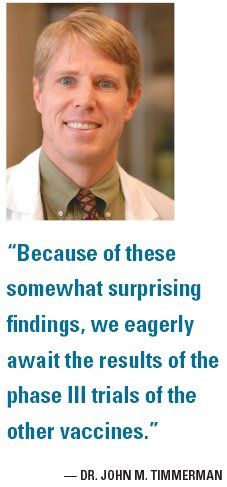Little benefit seen for personalized anti-Id vaccine in non-Hodgkin’s lymphoma
SAN DIEGO-Results were disappointing for an adjuvant immunotherapy approach to follicular non-Hodgkin’s lymphoma presented at the 2008 American Association for Cancer Research annual meeting (abstract LB-204).
ABSTRACT: A subset of immune responders did benefit. Phase III results for two other idiotype vaccines for NHL are still to come.
SAN DIEGO-Results were disappointing for an adjuvant immunotherapy approach to follicular non-Hodgkin’s lymphoma presented at the 2008 American Association for Cancer Research annual meeting (abstract LB-204).
In a multicenter, double-blind phase III trial of 287 patients, Genitope’s MyVax personalized immunotherapy vaccine provided no additional benefit over a non-directed immune approach, although a subset of “super immune responders” did appear to benefit, reported Ronald Levy, MD, of Stanford University School of Medicine.
MyVax consists of a tumor-specific Id protein, custom-made from the patient’s own tumor cells, conjugated to keyhole limpet hemocyanin (KLH), an immunogenic carrier protein.
Previously untreated patients received standard chemotherapy and were then randomized 2:1 to the specific Id-KLH plus GM-CSF vaccine or to a nonspecific KLH plus GM-CSF vaccine. The patients received a series of seven monthly vaccines given over 28 weeks.
Study results
Median progression-free survival was 19 months for the MyVax arm and 23 months for the control arm (P = .297). Time to subsequent therapy was 43 months and 48 months, respectively (P = .63), Dr. Levy reported.
The outcomes were more promising in the subset of patients who mounted an anti-Id immune

response, where time to pro- gression was doubled, compared with anti-Id-negative subjects (40 months vs 16 months, P = .0003).
Further, the “super immune responders,” those in the top half of the peak titers, “had a greater advantage in PFS, with a very significant P value difference,” Dr. Levy said, compared with controls and with the rest of the specifically treated group.
‘Patients somehow benefited’
Dr. Levy noted good results in both arms of the study: Clinical responses improved up to 2 years post-treatment in over half the patients. In addition, patients with high FLIPI scores fared no worse than those with lower scores, which means that vaccination resulted in the nonperformance of FLIPI as a predictor of outcome, he added.
“There was evidence, therefore, that patients somehow benefited.” Dr. Levy suggested the benefit might somehow be related to the nonspecific KLH carrier protein that the controls received.
Three idiotype vaccines being tested
Investigators in the field of NHL have long believed in the potential of therapeutic vaccination with tumor-specific Id protein, commented the paper’s discussant John M. Timmerman, MD, of the UCLA Lymphoma Program. The results, therefore, of three phase III trials of idiotype vaccines for the adjuvant treatment of follicular NHL have been eagerly anticipated.
The three idiotype vaccines differ primarily in how they are constructed.
The results for Genitope’s MyVax were reported at the AACR annual meeting by Dr. Levy, and data from the Accentia/Biovest (BiovaxID) and the Favrille (Specifid) trials should be revealed soon, Dr. Timmerman commented.
Of the MyVax study, “We all expected to see some separation of the progression-free survival curves between the specific and nonspecific vaccinated groups, even a modest one. But we didn’t,” Dr. Timmerman said.
What went wrong? “One possibility is that the Id-KLH vaccination does not work in lymphoma. I soundly reject this idea, based on earlier studies showing remarkable regression of tumor with Id-KLH vaccines,” he said.
The lack of efficacy may, instead, relate to a high level of residual tumor at the time of vaccination or to suboptimal vaccine formulation and manufacture, ie, the use of the recombinant IgG3 backbone for Id or prolonged glutaraldehyde conjugation, which might impair Id-KLH potency, he suggested.
“Because of these somewhat surprising findings, we eagerly await the results of the phase III trials of the other vaccines,” Dr. Timmerman said.